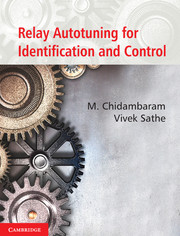Book contents
- Frontmatter
- Contents
- List of Figures
- List of Tables
- Acknowledgements
- Preface
- 1 Introduction
- 2 Improved Autotune Identification Methods
- 3 Cascade Controllers Tuning by Relay Autotune Method
- 4 Simultaneous Relay Autotuning of Cascade Controllers
- 5 A Simple Method of Tuning Cascade Controllers
- 6 Improved Saturation Relay Test for Systems with Large Dead Time
- 7 Identification of FOPTD Model using Single Symmetrical Relay Test
- 8 Autotuning of PID Controllers for Unstable FOPTD Systems
- 9 Autotuning of PID Controllers for Critically Damped SOPTD Systems
- 10 Estimation of SOPTD Transfer Function Model
- 11 Estimation of Five Parameters of Unstable SOPTD Model with a Zero
- 12 Identification of FOPTD Multivariable Systems
- 13 Identification of SOPTD Multivariable Systems
- 14 Tuning of Multivariable Controllers for Non-Minimum Phase Systems
- 15 Tuning of Multivariable Controllers by Genetic Algorithms
- 16 Summary and Conclusions
- Appendix A
- Appendix B
- Appendix C
- Nomenclature
- Problems
- Suggestive Reading
- References
- Index
Appendix C
Published online by Cambridge University Press: 05 June 2014
- Frontmatter
- Contents
- List of Figures
- List of Tables
- Acknowledgements
- Preface
- 1 Introduction
- 2 Improved Autotune Identification Methods
- 3 Cascade Controllers Tuning by Relay Autotune Method
- 4 Simultaneous Relay Autotuning of Cascade Controllers
- 5 A Simple Method of Tuning Cascade Controllers
- 6 Improved Saturation Relay Test for Systems with Large Dead Time
- 7 Identification of FOPTD Model using Single Symmetrical Relay Test
- 8 Autotuning of PID Controllers for Unstable FOPTD Systems
- 9 Autotuning of PID Controllers for Critically Damped SOPTD Systems
- 10 Estimation of SOPTD Transfer Function Model
- 11 Estimation of Five Parameters of Unstable SOPTD Model with a Zero
- 12 Identification of FOPTD Multivariable Systems
- 13 Identification of SOPTD Multivariable Systems
- 14 Tuning of Multivariable Controllers for Non-Minimum Phase Systems
- 15 Tuning of Multivariable Controllers by Genetic Algorithms
- 16 Summary and Conclusions
- Appendix A
- Appendix B
- Appendix C
- Nomenclature
- Problems
- Suggestive Reading
- References
- Index
Summary
C.1 Relay Tuning of Integrating Plus FOPTD Systems
The most used dynamic model for chemical engineering process is the FOPTD model. In many cases, time constant is very large; in some cases, dead time is the dominant one. In the literature, industrial examples of large time constants are reported by McNeill and Sacks (1969) for distillation and by Westerlund et al. (1980) for cement production. Some of the processes such as heating boilers, liquid storage tanks and batch chemical reactors are examples of integrating processes in industrial and chemical plants (Liu et al., 2005)
Zhang et al. (1999) proposed PID controller design method for integrating process with dead time and time constant. Kwak et al. (1997) proposed an online identification and autotuning method for integrating process. Kookos et al. (1999) proposed online PI controller tuning for integrating/dead time processes. Tian and Gao (1999) proposed a control scheme for integrating process with dominant time delay. The proposed scheme consist of a local proportional feedback to pre-stablize the process, a proportional controller for set-point tracking and a PD controller for load disturbance rejection. Huzmezan et al. (2002) designed a PID controller based on adaptive predictive control strategy to handle integrating type processes with large time constant. An industrial example of temperature control of a process that involves the heating and cooling of a batch reactor is studied.
C.2 Improved Analysis of Relay Tuning
The transfer function model for the integrating plus FOPTD system is given by Kp exp(-Ds)/[s(τs + 1)].
- Type
- Chapter
- Information
- Relay Autotuning for Identification and Control , pp. 230 - 238Publisher: Cambridge University PressPrint publication year: 2014



